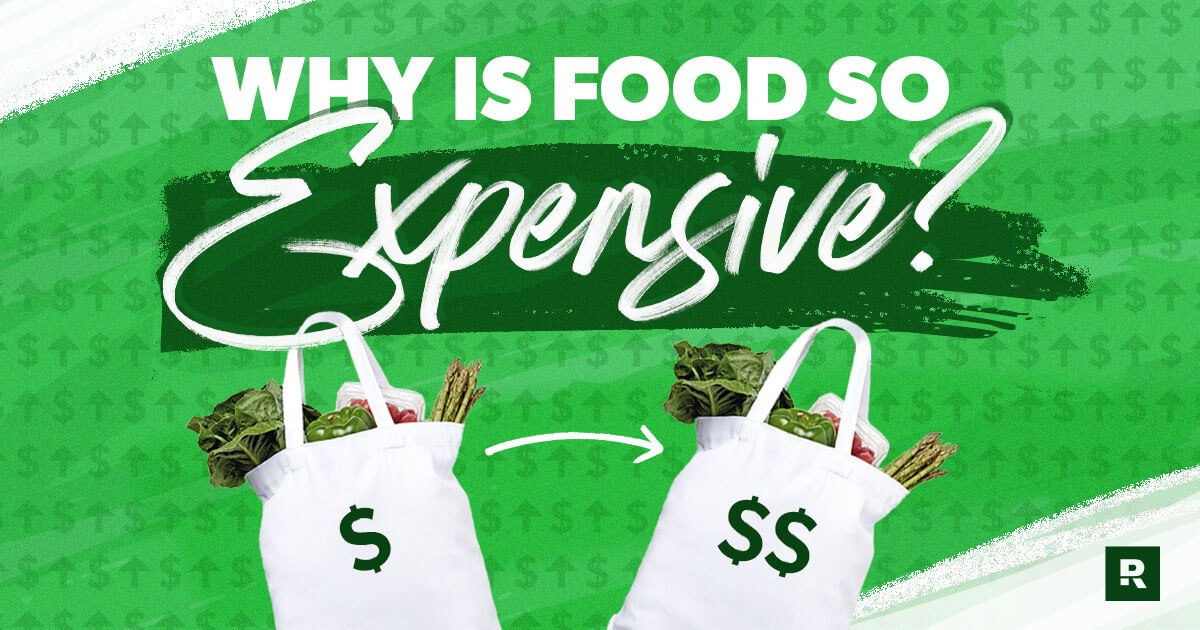You watch in disbelief as the cashier scans the items from your cart. Beep. Five dollars for a jar of peanut butter? Beep. Those tomatoes are double what they were last month! Beep. When did mac and cheese become a luxury item? And by the time you hear the grand total, your jaw is on the floor.
Trust us, you’re not the only person asking, “Why are food prices going up?” Grocery prices (and food prices in general) are high, and everyone’s feeling the sticker shock. Suddenly, you’re having to get the generic brand of Oreos just to stick to your budget. It’s enough to make you throw a tantrum in Aisle 7—right next to the 5-year-old begging for a candy bar.
But don’t crash your shopping cart in a rage just yet. We’re getting to the bottom of why food is so expensive right now. Plus, we’ve got some ways to help you save money and make your dollars go further at the grocery store and beyond.
Why Are Food Prices Going Up?
What Food Prices Are Rising the Most?
When Will Food Prices Come Down?
How to Save on Food (Despite Rising Costs)
Why Are Food Prices Going Up?
From supermarket runs and restaurant meals to takeout orders and Girl Scout cookies, food prices have been steadily growing for decades. You might have even noticed packaged snacks getting smaller and smaller (it’s called shrinkflation).
The food price surge may have cooled down a bit (especially for eggs), but the cost of groceries and eating out is still higher year over year. In fact, from February 2023 to February 2024, food prices went up 2.2% overall.1
Why? Well, there are a lot of ingredients that make up the recipe for food inflation—including droughts, high production costs and labor shortages.
All these things and more affect the number you see on your grocery receipt and restaurant check. But let’s break down some of the main causes happening right now.
Droughts
The price of food depends a lot on the climate. Drought, fire, crazy weather and other natural factors can ruin crops and make food prices rise for everyone (even years down the road).
Droughts and intense heat in many parts of the world (including right here in the U.S.) have made it harder to grow fruits and vegetables, which means less availability and higher prices in the produce aisle. Also, the lack of rainfall affects hay production, so ranchers have less to feed their cattle and are forced to reduce their herds. And since cattle numbers are going down, the price you pay for beef goes up.
Dry spells in India and Thailand (some of the globe’s top sugarcane producers) have also driven up the cost of sugar and sugar-packed products on the shelves.
High Production Costs
Believe it or not, that package of beef or bag of apples doesn’t just appear at the grocery store like magic (if only it were that simple). It all starts on a farm. Right now, farmers have to pay more to get the seeds, fertilizers, animal feed and equipment they need to grow and process all the delicious foods we eat. And extra cost for farmers means extra cost for you, the consumer.
Plus, wage increases for those working in food production (including processing plants, warehouses and grocery stores) also impact the total on your grocery receipt—especially if you buy a lot of heavily processed foods (think Goldfish and Frosted Flakes).
Labor Shortages
Right now, there’s a labor shortage in the food industry—especially when it comes to agriculture and food manufacturing. The number of farmworkers in America has been steadily declining for decades. And as more and more farmers reach retirement age, there aren’t enough people entering the field to maintain the same output.
Try our free Meal Planner to save money on groceries!
But even though there are fewer people helping to produce our country’s food supply, America’s appetite isn’t getting any smaller. And when people buy food faster than it can be produced, you guessed it—your grocery bill gets bigger.
What Food Prices Are Rising the Most?
As you can see, there are many factors that can cause food prices to rise. But a lot of it has to do with the specific types of foods. So, which foods are going up the most?
Well, exactly how much you pay depends on your location and grocery store. But the Consumer Price Index keeps a record of the average food prices across America for each month. Here are the foods that have gone up in cost the most from February 2023 to February 2024:2

- Beef and Veal: 7.4%
- Sugar and Sweets: 4.9%
- Dried Beans, Peas and Lentils: 2.4%
- Juices and Nonalcoholic Drinks: 2.3%
- Canned Vegetables: 2.1%
- Fats and Oils: 2.0%
- Cereals and Bakery Products: 1.7%
- Fresh Vegetables: 1.3%
This increase doesn’t just affect grocery prices. You’ve probably noticed some extra dollars tacked onto the receipt at your favorite restaurant or fast-food joint. In fact, the price of food away from home (aka eating out) increased 4.5% since February 2023.3 So much for those dollar-menu chicken nuggets!
When Will Food Prices Come Down?
We’ve got some bad news and some good news. Food prices are expected to continue to go up in 2024 (womp womp)—just not as much as previous years (yay?). The U.S. Department of Agriculture predicts that all food prices will increase around 2.9% in 2024.4 Not terrible but also not great.
Hopefully, we’ll see food production costs go down and labor shortage issues get resolved. But it can take literal years for these factors to change the price you pay at checkout. And as always, farmers can’t control the weather. So, we’re probably going to be riding out the rising food-price wave for a while.
How to Save on Food (Despite Rising Costs)
Okay, enough with all the depressing stuff. Yes, food prices are going up. But we’ve still got to eat, right?
The good news is, there’s still hope for your grocery budget. Because while you may not be able to control the price of food, you can control how you buy it. Here are some things you can do to combat inflation and save money on groceries.
Do your research.
Meal planning is a great way to make sure you’re keeping costs low and only buying what you need. Now more than ever, it’s a good idea to do a little research before you make your shopping list.
See what’s in season and what’s on sale at your local supermarket. Are diced tomatoes buy three, get three free? Looks like you’re making salsa! You can save a ton of money just by planning your meals around weekly specials.
Use what you have.
Nobody likes wasting food—especially when throwing away one avocado is like throwing $3 in the trash. So, before you head out to the store, take a long, hard look inside your fridge and pantry. See if you can use what you already have to make a meal, even if you don’t have all the ingredients.
Got some rice? Add some beans to your list. A little bit of milk in the fridge? Use it to make pancakes. Leftover chicken tenders? Grab some tortillas and make tacos. Taking inventory each week will help you save money and keep you from throwing out perfectly good food. It’s a win-win!
Buy generic brands.
Even though prices are going up, you can still shave a couple dollars off the total cost by choosing generic brands. You might not be willing to give up your name-brand cereal or cookies right now, but most staples (like milk, canned vegetables, spices and flour) are practically the same.
In fact, Consumer Reports says most store brands are similar enough to the name brands in overall taste and quality—and they’re usually 20% to 25% lower in price.5 Just be sure to compare prices while you’re in the aisle so you know you’re actually saving money.
Switch up where you shop.
Higher prices are everywhere, but you can still save money by shopping at cheaper grocery stores. Places like Aldi, Trader Joe’s and H-E-B keep costs low for their customers by carrying store brands, focusing on local foods, or making you bag your own groceries.
And don’t forget about your local farmers market. But wait, aren’t farmers markets more expensive? Not always! With food transportation costs as high as they are right now, you might actually get a better deal on eggs and local produce than you would at the grocery store. Plus, you’re helping support local farmers.
Cut back on the meat.
Listen, we’re not saying you need to suddenly become a vegetarian. But the price of meat is pretty ridiculous right now. You may not be ready to give up your morning bacon ritual just yet, but try replacing a couple of meals throughout the week with a nice salad, pasta or veggie dish. There are lots of great meatless recipes out there, and you might just find a new favorite.
Freeze your meals.
If you’re worried about food prices continuing to rise, you can stock up on ingredients now and freeze some meals for later. All you need is a day to cook up a couple casseroles and some room in your freezer. Just be sure to make things you won’t mind eating on repeat for a while.
Adjust your food budget.
The best way for you to fight food inflation is with a budget. Because when you’ve made a plan for your money before the month begins, you can shop those grocery store aisles with confidence. Plus, the great thing about a budget is that you can adjust it—and you should!
Because let’s be honest, even after using all of these food-saving tips, you might still end up spending more than you usually would on food. But when you budget with EveryDollar, it’s super easy to track all your food purchases, move some numbers around, and see where you can cut back in other areas. Your budget is there to work for you, not against you.
And listen, food prices may be going up, but you will get through this. All it takes is intentional planning, some focus, a little bit of creativity, and of course, your trusty budget.
Meal planning on a budget?
Save time and money each week with the Rachel Cruze Meal Planner & Grocery Savings Guide.
Get the Guide
Read the full article here






